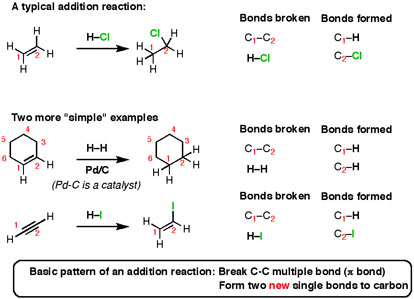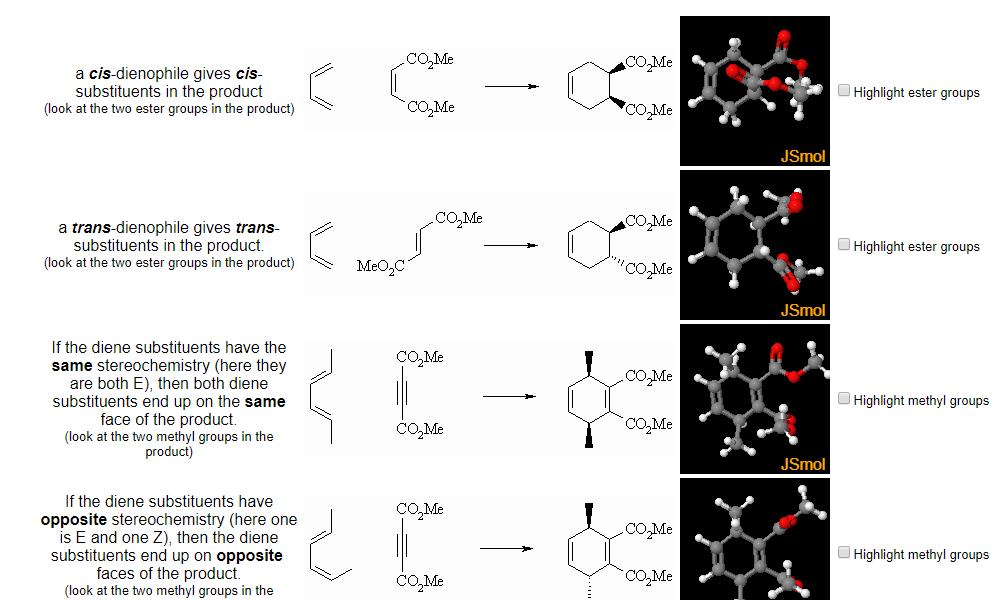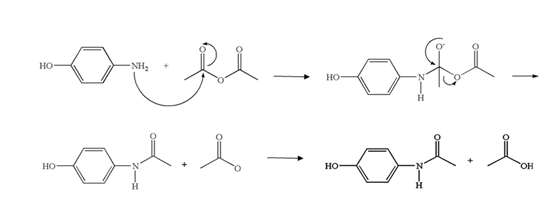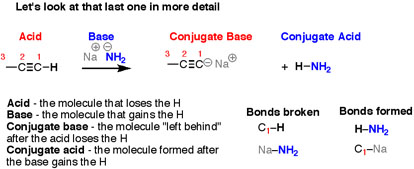UNIT-2
Organic Reactions and Synthesis of Drug Molecules
1.Explain the Addition reaction with an example?
When an alkene (or alkyne) is taken and certain types of reagents are added to them, the resulting reaction is shown . If any bonds can be recognized, the bonds formed and broken should be recognised.

The reaction shows an Addition reaction, to an Alkene a suitable reagent is added,the C-C multiple bonds are broken and two new single carbon bonds are formed.
Here’s the basic pattern: break a C-C multiple bond (also called a π bond) and form two new single bonds (“σ-bonds” to carbon). This reaction is called an “addition reaction” and it’s antypical type of common reaction. Note that the reaction occurs only at the carbons that are a part of a multiple bond – nothing else on the molecule gets affected.
2. Define Nucleophilic additon reactions?
A nucleophilic addition reaction is a chemical addition reaction in which a nucleophile forms a sigma bond with an electron deficient species. These reactions are considered very important in organic chemistry since they enable the conversion of carbonyl groups into a variety of functional groups. Generally, nucleophilic addition reactions of carbonyl compounds can be broken down into the following three steps.
- The electrophilic carbonyl carbon forms a sigma bond with the nucleophile.
- The carbon-oxygen pi bond is now broken, forming an alkoxide intermediate (the bond pair of electrons are transferred to the oxygen atom).
- The subsequent protonation of the alkoxide yields the alcohol derivative.
The carbon-oxygen double bond is directly attacked by strong nucleophiles to give rise to the alkoxide. However, when weak nucleophiles are used, the carbonyl group must be activated with the help of an acid catalyst for the nucleophilic addition reaction to proceed.
3.Define Elimination reactions?
An elimination reaction is a type of chemical reaction where several atoms either in pairs or groups are removed from a molecule. The removal usually takes place due to the action of acids and bases or action of metals. It can also happen through the process of heating at high temperatures.
Important Methods of Elimination Reaction
Normally, elimination reactions are distinguished by the kind of atoms or groups of atoms that leave the molecule. Due to this, there are two main methods involved in this type of reaction;
- Dehydration
- Dehydrohalogenation
In the dehydration method, there is the elimination of a water molecule mostly from compounds such as alcohol. Sometimes, this method is also called Beta elimination reaction where the leaving group and H are placed at neighbour carbon atoms. On the other hand, in dehydrohalogenation, there is a removal of a hydrogen atom and a halogen atom.

Elimination Reactions,these reactions are the reverse of addition reactions.
This reaction results in the formation of a new C-C double bond (π bond) and breaking oftwo single bonds to carbon (in such cases, one of them is H and the other is a halide such as Cl or Br). Howevera new bond is formed between H and the O. So in this case, this reaction incorporates a pattern we have already seen before – an acid-base reaction. Finally, a salt is formed in this reaction. But since the prime interest here is the organic product (that is, the one containing carbon), however, the salt byproduct is not written in some reaction schemes, but that doesn’t mean that it’s not present there.
NOTE
The three events in the elimination reaction of Fig (formation of C-C π bond, andbreaking of two adjacent carbon sigma bonds) are the exactly opposite to the addition reactions discussed before.
Another example of an elimination reaction, is when 2-bromopropane is heated under reflux with a concentrated solution of sodium or potassium hydroxide in ethanol. Heating under reflux involves the heating with a condenser placed vertically in the flask to avoid loss of volatile liquids. The product formed from this reaction is Propene is and, because this is a gas, it passes through the condenser and is be collected.


Everything else that is present (including anything formed in the alternative substitution reaction) will be trapped in the flask.
In this elimination reaction, which bonds are broken and with are formed, if any?
CH3−CH(OH)−CH3−→−−−−K2Cr2O7H2SO4CH3−C(=O)−CH3onumber(27.1.4)(27.1.4)CH3−CH(OH)−CH3→K2Cr2O7H2SO4CH3−C(=O)−CH3onumber
4. Explain oxidation reduction reactions?
We find examples of oxidation-reduction or redox reactions almost every time we analyze the reactions used as sources of either heat or work. When natural gas burns, for example, an oxidation-reduction reaction occurs that releases more than 800 kJ/mol of energy.
CH4(g) + 2 O2(g)  CO2(g) + 2 H2O(g)
CO2(g) + 2 H2O(g)
The best example that happens within our bodies, is a sequence of oxidation-reduction reactions that occur to burn sugars, such as glucose (C6H12O6) and the fatty acids in the fats that we eat.
C6H12O6(aq) + 6 O2(g)  |
CH3(CH2)16CO2H(aq) + 26 O2(g)  |
These reactions can also be used as a source of energy, however, to find examples of oxidation-reduction reactions. Silver metal, for example, is oxidized when it comes in contact with trace quantities of H2S or SO2 in the atmosphere or foods, such as eggs, that are rich in sulfur compounds.
4 Ag(s) + 2 H2S(g) + O2(g)  2 Ag2S(s) + 2 H2O(g)
2 Ag2S(s) + 2 H2O(g)
Surprisingly, the film of Ag2S that is formed collects on the metal surface and forms a protective coating that slows down further oxidation of the silver metal.
The given example of tarnishing of silver is just one of the reactions that occurin a broad class of oxidation-reduction reactions that come under the general heading of corrosion. Another example that occurs in a series of reactions when iron or steel rusts. When iron is heated, it reacts with oxygen to form a mixture of iron(II) and iron(III) oxides.
2 Fe(s) + O2(g)  |
2 Fe(s) + 3 O2(g) 2 Fe2O3(s) |
Molten iron even reacts  with water to form an aqueous solution of Fe2+ ions and H2 gas.
with water to form an aqueous solution of Fe2+ ions and H2 gas.
Fe(l) + 2 H2O(l)  Fe2+(aq) + 2 OH-(aq) + H2(g)
Fe2+(aq) + 2 OH-(aq) + H2(g)
At room temperature, however, all three of these reactions are so slow they can be easily ignored.
Iron canonly corrodes at room temperature in the presence of both water and oxygen. In the sequence of this reaction, the iron gets oxidized to give a hydrated form of iron(II) oxide.
2 Fe(s) + O2(aq) + 2 H2O(l)  2 FeO H2O(s)
2 FeO H2O(s)
Because iron(II) oxide has the same empirical formula as Fe(OH)2, usually iron(II),is mistaken and also called as ferrous hydroxide. The FeO H2O formed in this reaction is further oxidized by O2 dissolved in water to give a hydrated form of iron(III), or ferricoxide.
4 FeO H2O(s) + O2(aq) + 2 H2O(l)  2 Fe2O3 3 H2O(s)
2 Fe2O3 3 H2O(s)
In a further complicated reaction, FeO H2O formed at the metal surface combines with Fe2O3 3 H2O to give a hydrated form of magnetic iron oxide (Fe3O4) shown in the reaction below.
FeO H2O(s) + Fe2O3  3 H2O(s) Fe3O4 n H2O(s)
3 H2O(s) Fe3O4 n H2O(s)
As these reactions only can occur in the presence of both water and oxygen, cars tend to rust easily wherever water collects. Furthermore, because the simplest way of preventing iron from rusting is to coat the metal surface so that it doesn't come in contact with water, cars were originally painted for only one reason  to slow down the formation of rust.
to slow down the formation of rust.
5. What is a Diels Alder reaction?
- The Diels-Alder reaction is a conjugate addition reaction of a conjugated diene to an alkene (the dienophile) to produce a cyclohexene.
- The simplest example is the reaction of 1,3-butadiene with ethene to form cyclohexene:

- The analogous reaction of 1,3-butadiene with ethyne to form 1,4-cyclohexadiene is also known:

- Since the reaction forms a cyclic product, via a cyclic transition state, it can also be described as a "cycloaddition".
- The reaction is a concerted process:

Due to the high degree of regio- and stereoselectivity (due to the concerted mechanism), the Diels-Alder reaction is a very powerful reaction and is popularly used in synthetic organic chemistry.
- The reactionare usually thermodynamically favourable due to the conversion of 2 π-bonds into 2 new stronger σ-bonds.
- The two reactions shown above require harsh reaction conditions, but the normal Diels-Alder reaction is favoured by electron withdrawing groups on the electrophilic dienophile and by electron donating groups on the nucleophilic diene.
- Some common examples of the components are shown below:
Dienes |  |
Dienophiles |  |
Stereoselectivity:
- The Diels-Alder reaction is stereospecific with respect to both the diene and the dienophile.
- Addition is sync on both components (bonds form from same species at the same time)
- This is illustrated by the examples below where you should compare the relative positions substituents in the JSMOL images:

The picture shows the relative positions of dienophile and diene substituents.
Cyclic dienes can give stereoisomeric products depending on whether the dienophile lies under or away from the diene in the transition state. The endo product is usually the major product (due to kinetic control)

Cyclic dienes can give stereoisomeric products depending on whether the dienophile lies under or away from the diene in the transition state.
6. Explain the synthesis of drug Aspirin?
Aspirin (acetylsalicylic acid) is a synthetic organic derived from salicylic acid. Salicylic acid is a natural ingredient that was used by the ancient Greeks and Native Americans, among others, it found in the bark of the willow treeand is used to counter fever and pain. However, it is known that salicylic acid is bitter and irritates the stomach.
Felix Hoffman a German chemist, is credited with being the first to synthesize aspirin in 1897. Hoffman's father had severe arthritis he used salicylic acid to relieve pain but could not tolerate salicylic acid. The name given for Hoffman's new compound was A-spirin. Apparently this name comes from acetylation (A-), together with Spirinthat is part of the name given for Meadow-sweet (Spiraea ulmaria), a plant rich in salicylates.
Friedrich Bayer, the employer of Hoffman, patented the name and began marketing the product in 1899. The product was a huge success and sales grew rapidly. Bayer's company ,which he set up by himself, is reckoned to have been the first pharmaceutical company, and the production of aspirin is accepted to have laid the foundation of the modern pharmaceutical industry.
In this experiment aspirin (acetylsalicylic acid, C9H8O4 ) is synthesized and purified, and the percent yield is determined. The purity of the product formedis confirmed by measuring its melting point range andqualitative analysis.
The reaction that is used for the synthesis is shown below. In this reaction, an excess of acetic anhydride (C4H6O3) is added to a measured mass of salicylic acid (C7H6O3) in the presence of a catalyst, sulfuric acid (H2SO4). The mixture is heated to form the acetylsalicylic acid (C9H8O4) and acetic acid (C2H4O2). After the reaction takes place, water is added to destroy the excess acetic anhydride and cause the product to crystallize. The aspirin is then collected, purified by recrystallization, and its melting temperature measured.
 |
7. Explain the synthesis of Paracetamol?
N-(4-hydroxyphenyl)ethanamide, also known as Paracetamol or acetaminophen is one of the widely used drugs, paracetamol has the molecular formula C8H9NO2. Paracetamol is an analgesic (relieves pain) and also antipyretic(relieves fever)It is an analgesic (pain reliever) and also an antipyretic (fever reliever). Therefore it is widely used to relieve humans from mild to moderate pain, like cold , high temperature etc For pain relief it works by interfering with certain chemicals in the body called prostaglandins.they are sythesised in every cell of the body. They remain in the cell that they are synthesised in and do not migrate to ther sites, they acts as chemical messengers like hormones. The area in the brain called the hypothalamus regulates our body temperature, paracetamol is known to act on this area, to reduce temperature., paracetamol works by inhibiting the production of prostaglandins making the body less aware of the pain or injury.
The synthesis of the amide essentially requires running the reaction under cerain conditions with an appropriate catalyst. Paracetamol is prepared from p-aminophenol by acetylating it with acetic anhydride in the presence of 3-4 drops of concentrated sulphuric acid as catalyst.
Reaction:

Mechanism:

The formation of paracetamol is a process that consists of two stages. The first stage an acid catalysed reaction occurs resulting in the formation of crude acetaminophen, the reaction takes place is a nucleophilic addition reaction,in which the nitrogen atom of p-aminophenol is the nucleophile that attacks the carbonyl group of the acetic anhydride that forms as a intermediate compound which further undergoes elimination of the acetate anion.
Recryastallization process at optimum temperature is carried out to improve and yield adequate purity of paracetamol.
8. Give an example of acid base reaction?
Another important category of organic reactions are straight-forward Brønsted–Lowry acid-base reactions.

Fig.2: Acid/Base reactions
It can be noticed that the reactions look different on the surface – all those different structures! – but the basic plot of each reaction is the same. We are breaking an H-(atom) bond and forming an H-(atom) bond. At the same time, two “leftover” partners connect together to form a salt, composed of two oppositely-charged ions. Let’s look at that last reaction in more detail. Here, the breaking of a C-H bond and an (ionic) Na-NH2 bond, and forming an N-H bond as well as an (ionic) C-Na bond.

Fig. 3: There are four “actors” in this reaction – as there are in every acid-base reaction
- In the reaction, the bond to H is breaking is the acid.
- The next level where, where the bond to H is forming is the base
- The product that is formed,iswhen the bond to H is brokenit is called the conjugate base.
- The product that is formed, when the bond to H is formed is called the conjugate acid.
When,the reverse of the previous reaction is looked into carefully, the breaking of a bond to H and forming a bond to H happens, but after swapping everything , the breaking of N-H and C-Na takes place, and forming of N-Na and C-H occurs.
It’s still an acid-base reaction.

Fig.4: The four reactions that take place in this reaction, Acid-Base-Conjugate Base-Conjugate Acid.
However, experiment tells us that this reaction does not happen to any appreciable extent.
In this acid/base reaction, which are the bonds that are broken and which bonds are formed, if any?
(CH3−CH2)3N+HCl→(CH3−CH2)3NH++Cl−onumber(27.1.1)(27.1.1)(CH3−CH2)3N+HCl→(CH3−CH2)3NH++Cl−onumber
9.Define an intermediate?
An intermediate is a process which appears in the mechanism of a reaction, but not in the overall balanced equation. An intermediate is always formed in an early step in the mechanism and consumed in a later step.